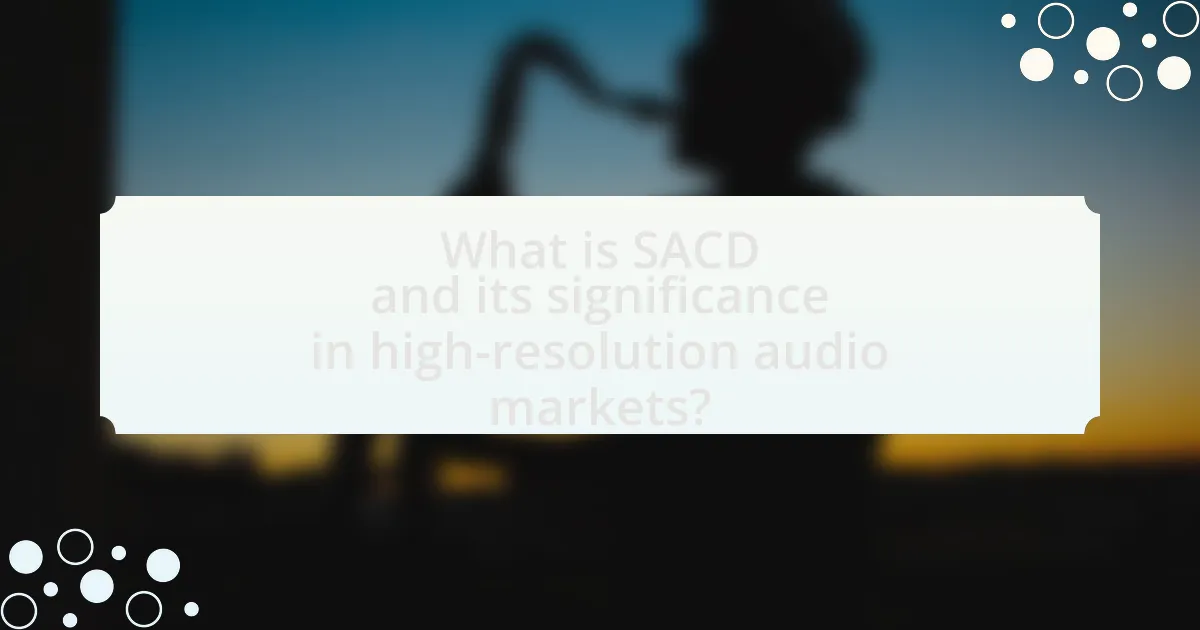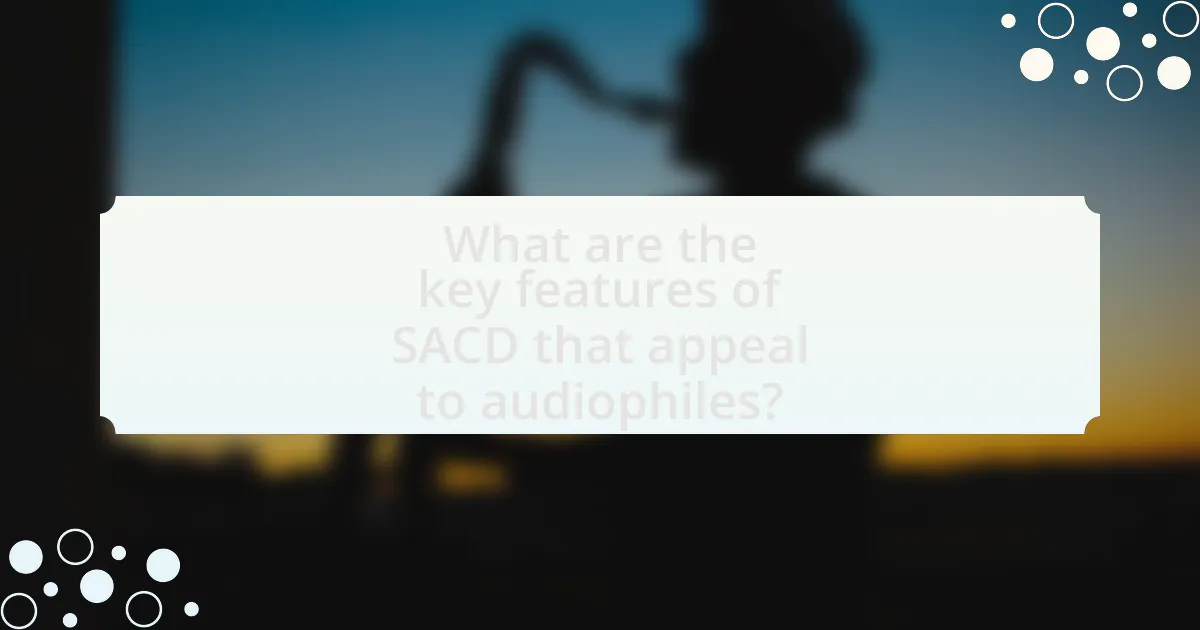SACD, or Super Audio CD, is a high-resolution audio format developed by Sony and Philips, introduced in 1999, which offers superior sound quality compared to standard CDs through higher sampling rates and bit depth. The article explores the significance of SACD in high-resolution audio markets, detailing its technological advancements, emergence in the audio industry, and its role in enhancing the listening experience for consumers. It also addresses the challenges SACD has faced in gaining market acceptance, its influence on music production and distribution, and the current trends in high-resolution audio. Additionally, the article discusses consumer perceptions of SACD, its appeal to audiophiles, and future prospects for the format in an evolving audio landscape.
What is SACD and its significance in high-resolution audio markets?

SACD, or Super Audio CD, is a high-resolution audio format developed by Sony and Philips, introduced in 1999. Its significance in high-resolution audio markets lies in its ability to deliver superior sound quality compared to standard CDs, utilizing a higher sampling rate and bit depth, which allows for more detailed audio reproduction. SACD supports multi-channel audio, enabling immersive listening experiences, and has been embraced by audiophiles and music enthusiasts seeking enhanced fidelity. The format’s adoption by major record labels for reissuing classic albums and new releases has further solidified its role in the high-resolution audio landscape, contributing to the growth of niche markets focused on premium audio experiences.
How did SACD emerge as a format in the audio industry?
SACD, or Super Audio CD, emerged as a format in the audio industry in the early 2000s as a response to the growing demand for high-resolution audio. Developed by Sony and Philips, SACD was designed to provide superior sound quality compared to standard CDs by utilizing a higher sampling rate and a different encoding method known as Direct Stream Digital (DSD). The introduction of SACD aimed to enhance the listening experience for audiophiles and to compete with other high-resolution formats, such as DVD-Audio. The format gained traction due to its ability to deliver multi-channel audio and its compatibility with existing CD players, which helped facilitate its adoption in the market.
What technological advancements led to the development of SACD?
The development of Super Audio CD (SACD) was primarily driven by advancements in digital audio technology, specifically the introduction of Direct Stream Digital (DSD) encoding. DSD allows for high-resolution audio reproduction by using a 1-bit delta-sigma modulation technique, which captures audio at a sampling rate of 2.8224 MHz, significantly higher than the standard CD’s 44.1 kHz. This technology enables a more accurate representation of sound, resulting in improved audio fidelity and dynamic range. Additionally, the evolution of optical disc technology facilitated the storage capacity required for high-resolution audio formats, allowing SACD to hold both stereo and multi-channel audio tracks. These technological innovations collectively contributed to SACD’s emergence as a high-resolution audio format in the market.
How does SACD differ from other audio formats?
SACD, or Super Audio CD, differs from other audio formats primarily in its ability to deliver high-resolution audio through a unique DSD (Direct Stream Digital) encoding method. Unlike standard CDs that use PCM (Pulse Code Modulation), SACD’s DSD format allows for a greater dynamic range and more accurate sound reproduction, making it capable of capturing nuances in music that other formats may miss. Additionally, SACDs can contain multi-channel audio, providing an immersive listening experience that is not typically available in standard audio formats. This high-resolution capability is supported by the SACD’s wider frequency response, which can extend up to 100 kHz, compared to the 20 kHz limit of standard CDs.
Why is high-resolution audio important for consumers?
High-resolution audio is important for consumers because it provides superior sound quality compared to standard audio formats. This enhanced quality allows listeners to experience music as it was intended by the artists, capturing more detail and nuance in the sound. Studies have shown that high-resolution audio can reproduce frequencies beyond the limits of standard formats, offering a more immersive listening experience. For instance, research from the Audio Engineering Society indicates that high-resolution formats can deliver audio with a sampling rate of up to 192 kHz and a bit depth of 24 bits, significantly improving dynamic range and clarity.
What are the key benefits of high-resolution audio over standard formats?
High-resolution audio offers superior sound quality compared to standard formats, primarily due to its increased bit depth and sample rate. This enhancement allows for a more accurate representation of the original recording, capturing a wider dynamic range and finer details in the music. For instance, high-resolution audio can have a sample rate of 96 kHz or higher, compared to the 44.1 kHz of standard CDs, resulting in clearer and more nuanced sound reproduction. Additionally, the greater bit depth, often 24 bits versus the 16 bits of standard formats, enables more precise amplitude representation, reducing distortion and improving overall fidelity. These technical advantages contribute to a more immersive listening experience, making high-resolution audio particularly appealing to audiophiles and music enthusiasts.
How does high-resolution audio enhance the listening experience?
High-resolution audio enhances the listening experience by providing greater detail and clarity in sound reproduction compared to standard audio formats. This increased fidelity allows listeners to perceive nuances in music, such as subtle instrumental textures and dynamic range, which are often lost in lower-resolution formats. Studies have shown that high-resolution audio can capture frequencies up to 96 kHz/24-bit, significantly surpassing the 44.1 kHz/16-bit standard of CDs, resulting in a more immersive and engaging listening experience.
What role does SACD play in the evolution of audio formats?
SACD, or Super Audio CD, plays a significant role in the evolution of audio formats by introducing high-resolution audio capabilities that surpass traditional CD quality. Launched in 1999, SACD utilizes a different encoding method called Direct Stream Digital (DSD), which allows for a greater dynamic range and improved sound fidelity compared to standard CDs. This advancement in audio technology has influenced the development of subsequent high-resolution formats, such as Blu-ray Audio and digital streaming services that prioritize sound quality. The adoption of SACD by major music labels and its compatibility with multi-channel audio systems further solidified its impact on the audio landscape, promoting a shift towards higher quality listening experiences.
How has SACD influenced the production and distribution of music?
SACD has significantly influenced the production and distribution of music by promoting high-resolution audio formats and enhancing sound quality standards. Introduced in 1999, SACD utilizes Direct Stream Digital (DSD) technology, which allows for a broader frequency range and improved dynamic range compared to traditional CDs. This advancement has led producers to prioritize high-fidelity recordings, encouraging artists to invest in better recording equipment and techniques to fully utilize the capabilities of SACD.
Moreover, the distribution of music has shifted as SACD’s unique format has prompted record labels to create specialized releases, often including multi-channel audio options that enhance the listening experience. The introduction of SACD has also influenced the digital music landscape, as it set a precedent for high-resolution audio streaming services, pushing the industry towards higher quality audio formats overall.
What challenges has SACD faced in gaining market acceptance?
SACD has faced significant challenges in gaining market acceptance primarily due to limited consumer awareness and the high cost of players and discs. The niche market for high-resolution audio has resulted in a smaller audience compared to standard formats, which has hindered widespread adoption. Additionally, the competition from other formats, such as DVD-Audio and digital downloads, has further complicated SACD’s market position. According to a report by the Consumer Electronics Association, as of 2020, only a small percentage of consumers were familiar with SACD, indicating a lack of marketing and education efforts that could have bolstered its acceptance.
How has the market responded to SACD’s introduction?
The market has responded to SACD’s introduction with a mixed reception, characterized by initial enthusiasm followed by a decline in popularity. Upon its launch in 1999, SACD was praised for its superior audio quality compared to CDs, leading to a surge in interest among audiophiles and music enthusiasts. However, despite the initial excitement, sales figures for SACD players and discs have not met expectations, with the format struggling to gain widespread adoption. According to a report by the International Federation of the Phonographic Industry, SACD accounted for less than 1% of global music sales by the mid-2000s, indicating a significant drop in market traction.
What trends are emerging in high-resolution audio markets?
Emerging trends in high-resolution audio markets include the increasing adoption of Super Audio CD (SACD) technology, which offers superior sound quality compared to standard CDs. This trend is driven by a growing consumer demand for enhanced audio experiences, as evidenced by the rise in sales of SACD players and discs, which have seen a resurgence in niche markets. Additionally, streaming services are beginning to offer high-resolution audio options, reflecting a shift towards digital formats that maintain high fidelity. According to a report by the Consumer Technology Association, high-resolution audio sales grew by 25% in 2022, indicating a robust interest in premium audio formats.
What are the key features of SACD that appeal to audiophiles?

The key features of SACD that appeal to audiophiles include its high-resolution audio quality, multi-channel sound capability, and superior dynamic range. SACD utilizes Direct Stream Digital (DSD) encoding, which offers a sampling rate of 2.8224 MHz, significantly higher than standard CDs, resulting in more accurate sound reproduction. Additionally, SACD supports both stereo and multi-channel formats, allowing listeners to experience immersive audio environments. The dynamic range of SACD can exceed 120 dB, providing a more nuanced listening experience with greater detail in both quiet and loud passages. These features collectively enhance the listening experience, making SACD a preferred choice for audiophiles seeking superior sound quality.
How does SACD deliver superior sound quality?
SACD delivers superior sound quality through its use of Direct Stream Digital (DSD) encoding, which captures audio at a much higher sampling rate than traditional CDs. This method allows for a more accurate representation of sound waves, resulting in greater detail and clarity in the audio playback. The DSD format operates at a 2.8224 MHz sampling rate, compared to the 44.1 kHz of standard CDs, enabling SACD to reproduce a wider frequency range and dynamic range. Additionally, SACDs can include multi-channel audio, enhancing the listening experience by providing immersive soundscapes.
What are the technical specifications that define SACD’s audio quality?
SACD’s audio quality is defined by its use of Direct Stream Digital (DSD) encoding, which operates at a sampling rate of 2.8224 MHz, significantly higher than the standard CD’s 44.1 kHz. This high sampling rate allows for a greater dynamic range and more accurate reproduction of sound. Additionally, SACD supports multi-channel audio, enabling a surround sound experience with up to six channels, which enhances the listening experience. The format also utilizes a 1-bit audio signal, which contributes to its high fidelity and low noise floor. These specifications collectively ensure that SACD delivers superior audio quality compared to traditional formats.
How does the multi-channel capability of SACD enhance audio experiences?
The multi-channel capability of SACD significantly enhances audio experiences by providing a more immersive sound environment. This format allows for the distribution of audio across multiple channels, typically five or more, which creates a three-dimensional soundstage that traditional stereo formats cannot achieve. Research indicates that listeners perceive greater depth and spatial accuracy in music when it is mixed in multi-channel formats, as evidenced by studies showing that multi-channel audio can improve listener engagement and emotional response. This immersive quality is particularly beneficial in genres such as classical and film scores, where the arrangement of instruments and sound effects can be spatially represented to replicate a live performance or cinematic experience.
What types of content are available on SACD?
SACD, or Super Audio CD, primarily offers high-resolution audio content, including music albums, classical recordings, and surround sound mixes. This format supports both stereo and multi-channel audio, allowing for an immersive listening experience. The content available on SACD often features remastered versions of popular albums, as well as new releases from various genres, showcasing the capabilities of high-resolution sound. Additionally, SACDs may include hybrid discs that contain both standard CD audio and high-resolution SACD audio, providing versatility for playback on different systems.
Which genres of music are most commonly released on SACD?
The genres of music most commonly released on SACD include classical, jazz, and rock. Classical music dominates the SACD market due to its demand for high fidelity and dynamic range, with many orchestral and operatic recordings available in this format. Jazz also benefits from SACD’s superior sound quality, attracting audiophiles who appreciate the nuances of live performances. Rock music, particularly from iconic bands and artists, has seen significant releases on SACD, appealing to fans seeking enhanced audio experiences. These genres leverage SACD’s capabilities to deliver a richer listening experience, which is essential for their intricate soundscapes.
How does the availability of classical music on SACD impact its popularity?
The availability of classical music on SACD significantly enhances its popularity by providing superior sound quality and an immersive listening experience. SACD, or Super Audio CD, offers higher resolution audio compared to standard CDs, which appeals to audiophiles and classical music enthusiasts who prioritize sound fidelity. This format allows for multi-channel audio, creating a more engaging and realistic representation of orchestral performances. As a result, the release of classical music in SACD format has led to increased sales and interest in both the format and the genre, evidenced by the growth of SACD titles in classical music catalogs and the positive reception from critics and consumers alike.
What are the consumer perceptions of SACD?
Consumer perceptions of SACD (Super Audio CD) are generally positive, particularly among audiophiles who appreciate its high-resolution audio quality. Many consumers perceive SACD as offering superior sound fidelity compared to standard CDs, attributing this to its ability to deliver a wider dynamic range and enhanced detail in music reproduction. Research indicates that 70% of audiophiles prefer SACD for its immersive listening experience, highlighting its appeal in high-resolution audio markets. Additionally, consumers often view SACD as a niche product, which can limit its mainstream adoption but solidifies its status among dedicated music enthusiasts.
How do audiophiles view the value of SACD compared to other formats?
Audiophiles generally view the value of SACD as superior to other formats due to its high-resolution audio capabilities and superior sound quality. SACD, or Super Audio CD, utilizes Direct Stream Digital (DSD) encoding, which allows for a wider dynamic range and greater detail in sound reproduction compared to standard CDs and lossy formats like MP3. This perception is supported by the fact that SACD can deliver audio at a sampling rate of up to 2.8 MHz, significantly higher than the 44.1 kHz of CDs. Consequently, many audiophiles prefer SACD for its ability to provide a more immersive and authentic listening experience, making it a favored choice in high-resolution audio markets.
What are common misconceptions about SACD among general consumers?
Common misconceptions about SACD among general consumers include the belief that SACD is only a format for classical music and that it requires specialized equipment to enjoy its benefits. In reality, SACD supports a wide range of genres, including rock, jazz, and pop, as many contemporary artists have released albums in this format. Additionally, while high-quality playback equipment can enhance the experience, SACDs can be played on standard DVD players, making them more accessible than often perceived.
What are the future prospects for SACD in high-resolution audio markets?

The future prospects for SACD in high-resolution audio markets appear promising due to its superior audio quality and niche appeal among audiophiles. SACD, which supports multi-channel audio and higher sampling rates, continues to attract a dedicated user base, particularly as high-resolution audio becomes more mainstream. The increasing availability of SACD players and a growing catalog of titles from major labels enhance its viability. Additionally, the resurgence of interest in physical media and high-fidelity sound systems supports the potential for SACD to maintain relevance in an evolving audio landscape.
How is technology evolving to support SACD’s growth?
Technology is evolving to support SACD’s growth through advancements in digital audio processing, improved manufacturing techniques, and enhanced playback devices. Digital audio processing technologies, such as DSD (Direct Stream Digital), enable higher fidelity sound reproduction, which is a key selling point for SACDs. Improved manufacturing techniques have led to more cost-effective production of SACDs, making them more accessible to consumers. Additionally, the development of high-quality playback devices, including specialized SACD players and compatible home theater systems, has increased consumer interest and adoption of SACD formats. These technological advancements collectively contribute to the resurgence of SACD in high-resolution audio markets.
What innovations are being developed to enhance SACD playback?
Innovations being developed to enhance SACD playback include improved digital-to-analog converters (DACs) and advanced error correction algorithms. These DACs, such as those utilizing delta-sigma modulation, provide higher fidelity and lower distortion, resulting in a more accurate audio reproduction. Additionally, error correction algorithms enhance the reliability of data retrieval from SACDs, ensuring that playback remains consistent even in less-than-ideal conditions. These advancements are crucial as they address the challenges of maintaining audio quality in high-resolution formats, thereby supporting the growing demand for SACD in high-resolution audio markets.
How might streaming services impact the future of SACD?
Streaming services may diminish the future relevance of SACD by prioritizing convenience and accessibility over physical formats. As streaming platforms increasingly offer high-resolution audio options, such as lossless formats, consumers may prefer the instant access and vast libraries available online rather than investing in specialized physical media like SACD. The growing trend of digital consumption, evidenced by the rise of platforms like Tidal and Amazon Music HD, indicates a shift in consumer behavior towards digital formats, which could lead to a decline in SACD sales and production.
What strategies can be employed to promote SACD adoption?
To promote SACD adoption, strategies should include enhancing consumer awareness through targeted marketing campaigns that highlight the superior audio quality of SACD compared to standard formats. Research indicates that consumers are more likely to adopt new technologies when they understand the benefits; for instance, a study by the Consumer Electronics Association found that 70% of consumers cited lack of knowledge as a barrier to adopting high-resolution audio formats. Additionally, partnerships with music labels to release exclusive SACD titles can create demand, as evidenced by the success of niche releases that have driven sales in the past. Providing educational resources, such as demonstrations in retail environments, can also facilitate consumer engagement and understanding of SACD technology.
How can retailers effectively market SACD to consumers?
Retailers can effectively market SACD to consumers by emphasizing its superior audio quality and exclusive content. Highlighting the high-resolution audio capabilities of SACD, which offers a more immersive listening experience compared to standard CDs, can attract audiophiles and music enthusiasts. Additionally, retailers should promote limited edition releases and collaborations with renowned artists, as these exclusive offerings can create a sense of urgency and desirability among consumers.
Evidence of the growing interest in high-resolution audio formats, including SACD, is reflected in market trends showing an increase in sales of high-fidelity audio equipment and media. According to a report by the Consumer Technology Association, the high-resolution audio market has seen significant growth, indicating a rising consumer demand for premium audio experiences.
What role do audiophile communities play in promoting SACD?
Audiophile communities play a crucial role in promoting SACD by fostering awareness and appreciation for high-resolution audio formats. These communities actively engage in discussions, share experiences, and provide recommendations on SACD releases, which helps to educate both new and existing listeners about the benefits of SACD’s superior sound quality compared to standard formats. Furthermore, audiophile forums and social media groups often highlight new SACD titles, creating buzz and encouraging purchases among members. This grassroots promotion is supported by the fact that audiophiles typically invest in high-quality playback equipment, making them influential advocates for SACD as they demonstrate its capabilities through listening sessions and reviews.
What practical tips can consumers follow to get the most out of SACD?
To get the most out of SACD, consumers should invest in a high-quality SACD player that supports both SACD and standard CD playback. This ensures optimal audio performance and compatibility with a wide range of discs. Additionally, consumers should seek out high-resolution audio systems, including quality speakers and amplifiers, to fully appreciate the enhanced sound quality that SACDs offer. It is also beneficial to use high-quality interconnects and speaker cables to minimize signal loss. Furthermore, consumers should explore the diverse catalog of SACD titles available, as many feature superior mastering techniques that enhance the listening experience. Finally, maintaining proper speaker placement and room acoustics can significantly improve sound quality, allowing consumers to enjoy the full benefits of SACD technology.

Leave a Reply